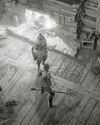On the long, transformative walk from research team to videogame studio

The Chinese Room’s Brighton office, with its corridor of frosted glass and rooms of filing cabinets and phones, looks more like the setting for a ’70s cop show than a game studio. Before it moved in, this was the building for the local branch of Unison, the public service union. It still very much feels like it: most of its rooms are unoccupied, canvases of concept art propped up against the skirting boards still waiting to be hung. Down the hallway is the main workspace, an open-plan room filled with busy desks.
It’s a haphazard arrangement. (Suspiciously so, in fact: we’re told the previous landlord was convinced some kind of gambling outfit was being operated in here.) But it suits The Chinese Room somewhat. “We became a game studio kind of accidentally,” co-founder Dan Pinchbeck says. He’d been working in the University Of Portsmouth’s creative technologies department on a doctorate on the uses of story and nontechnological elements to enhance presence in virtual reality. “I was playing TimeSplitters one night, and I went, ‘Wait – this is mass-market virtual reality!’” he laughs. “‘Why am I doing VR when I could be doing games?’” He switched the subject of his PhD to how story should be considered a mechanic. “I talked to a few people and they were like, ‘This is just theory’.” He and a few others began modding Doom and Half-Life 2 in an effort to gather data. They made a version of Doom 3 with rubber bullets to see how stunning enemies instead of killing them changed the gameplay (“You’d end up with 100 zombies following you around a level”).
この記事は Edge の October 2019 版に掲載されています。
7 日間の Magzter GOLD 無料トライアルを開始して、何千もの厳選されたプレミアム ストーリー、9,000 以上の雑誌や新聞にアクセスしてください。
すでに購読者です ? サインイン
この記事は Edge の October 2019 版に掲載されています。
7 日間の Magzter GOLD 無料トライアルを開始して、何千もの厳選されたプレミアム ストーリー、9,000 以上の雑誌や新聞にアクセスしてください。
すでに購読者です? サインイン

NO MORE ROOM IN HELL 2
You're not alone in the dark

WINDBLOWN
Life after Dead Cells

COLLECTED WORKS - JOSH SAWYER
Journeying to the Forgotten Realms, Infinity and beyond with the RPG veteran

SCREENBOUND
Going deep in a mind-bending hybrid of perspectives

Trigger Happy
Shoot first, ask questions later

Grand strategist
Paradox's Mattias Lilja addresses the publisher's recent difficulties - and the plan to right the ship

Diablo IV
A progress report on the games we just can't quit

Ghosts 'n Goblins Resurrection
In Capcom's diabolical tribute, evil goes far deeper than the demons on the screen

SERENITY FORGE
How a near-death experience lit a fire in the Colorado-based developer and publisher

THE MAKING OF...ALIEN: ISOLATION
How a strategy-led studio built a survival horror masterpiece in Ridley Scott's image